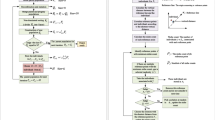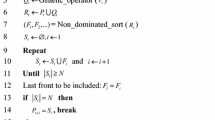Abstract
Nondominated-sorting plays an important role in multi-objective evolutionary algorithm in recent decades. However, it fails to work well when the target multi-objective problem has a complex Pareto front, brusque nondominated-sorting virtually steers by the conflicting nature of objectives, which leads to irrationality. In this paper, a novel mixed-factor evolutionary algorithm is proposed. A normalization procedure, i.e. mixed-factor, is introduced in the objective space, which links all the objectives for all the solutions of the problem to ease the conflicting nature. In the process of nondominated-sorting, the mixed factors of individual substitute the raw objectives. In order to ensure that the population are thoroughly steered through the normalized objective space, hybrid ageing operator and static hypermutation with first constructive mutation are used to guide the searching agents converge towards the true Pareto front. The algorithm proposed is operated on multi-objective knapsack problem. The effectiveness of MFEA is compared with five state-of-the-art algorithms, i.e., NSGA-II, NSGA-III, MOEA/D, SPEA2 and GrEA, in terms of five performance metrics. Simulation results demonstrate that MFEA achieves better performance.
Access this chapter
Tax calculation will be finalised at checkout
Purchases are for personal use only
Similar content being viewed by others
References
Schaffer, J.D.: Multiple objective optimization with vector evaluated genetic algorithms. In: Proceedings of the First International Conference on Genetic Algorithms and their Applications. Lawrence Erlbaum Associates. Inc. Publishers (1985)
Knowles, J.D., Corne, D.W.: Approximating the nondominated front using the pareto archived evolution strategy. Evol. Comput. 8(2), 149–172 (2000)
Zitzler, E., Laumanns, M., Thiele, L.: SPEA2: Improving the strength pareto evolutionary algorithm. TIK-report, p. 103 (2001)
Zitzler, E., Künzli, S.: Indicator-Based Selection in Multiobjective Search. In: Yao, X., Burke, E.K., Lozano, J.A., Smith, J., Merelo-Guervós, J.J., Bullinaria, J.A., Rowe, J.E., Tiňo, P., Kabán, A., Schwefel, H.-P. (eds.) Parallel Problem Solving from Nature - PPSN VIII. Lecture Notes in Computer Science, vol. 3242, pp. 832–842. Springer, Heidelberg (2004). https://doi.org/10.1007/978-3-540-30217-9_84
Zhang, Q., Li, H.: MOEA/D: a multi-objective evolutionary algorithm based on decomposition. IEEE Trans. Evol. Comput. 11(6), 712–731 (2007)
Li, H., Deb, K., Zhang, Q., Suganthan, P.N., Chen, L.: Comparison between MOEA/D and NSGA-III on a set of many and multi-objective benchmark problems with challenging difficulties. Swarm Evol. Comput. 46, 104–117 (2019). https://doi.org/10.1016/j.swevo.2019.02.003
Deb, K., Pratap, A., Agarwal, S., et al.: A fast and elitist multi-objective genetic algorithm: NSGA-II. IEEE Trans. Evol. Comput. 6(2), 182–197 (2002)
Deb, K., Jain, H.: An evolutionary many-objective optimization algorithm using reference-point-based nondominated sorting approach, part I: Solving problems with box constraints. IEEE Trans. Evol. Comput. 18(4), 577–601 (2014)
Yang, S., Li, M., Liu, X., et al.: A grid-based evolutionary algorithm for many-objective optimization. IEEE Trans. Evol. Comput. 17(5), 721–736 (2013)
Moslehi, F., Haeri, A.: An evolutionary computation-based approach for feature selection. J. Ambient. Intell. Humaniz. Comput. 11(9), 3757–3769 (2019). https://doi.org/10.1007/s12652-019-01570-1
Ragmani, A., Elomri, A., Abghour, N., Moussaid, K., Rida, M.: FACO: a hybrid fuzzy ant colony optimization algorithm for virtual machine scheduling in high-performance cloud computing. J. Ambient. Intell. Humaniz. Comput. 11(10), 3975–3987 (2019). https://doi.org/10.1007/s12652-019-01631-5
Wang, P., Xue, F., Li, H., Cui, Z., **e, L., Chen, J.: A multi-objective DV-hop localization algorithm based on NSGA-II in internet of things. Mathematics 7(2), 184 (2019). https://doi.org/10.3390/math7020184
Corus, D., Oliveto, P.S., Yazdani, D.: When hypermutations and ageing enable artificial immune systems to outperform evolutionary algorithm. Theoret. Comput. Sci. (2019). https://doi.org/10.1016/j.tcs.2019.03.002
Zhou, Z., Yang, Y., Qian, C.: Evolutionary Learning: Advances in Theories and Algorithms, pp. 6–9. Springer, Berlin (2019). https://doi.org/10.1007/978-981-13-5956-9
Lust, T., Teghem, J.: The multi-objective multidimensional knapsack problem: A survey and a new approach. Int. Trans. Oper. Res. 19(4), 495–520 (2012)
Karp, R.M.: Reducibility among combinatorial problems. In: Miller, R.E., Thatcher, J.W., Bohlinger, J.D. (eds.) Complexity of Computer Computations, pp. 85–103. Springer US, Boston, MA (1972). https://doi.org/10.1007/978-1-4684-2001-2_9
Kumar, R., Banerjee, N.: Analysis of a multi-objective evolutionary algorithm on the 0–1 knapsack problem. Theoret. Comput. Sci. 358(1), 104–120 (2006)
Zouache, D., Moussaoui, A., et al.: A cooperative swarm intelligence algorithm for multi-objective discrete optimization with application to the knapsack problem. European J. Oper. Res. 264(1), 74–88 (2018)
Oliveto, P.S., Sudholt, D.: On the runtime analysis of stochastic ageing mechanisms. In: Proceedings of the GECCO 2014, pp. 113–120 (2014)
Zitzler, E., Thiele, L.: Multi-objective evolutionary algorithms: A comparative case study and the strength pareto approach. IEEE Trans. Evol. Comput. 3(4), 257–271 (1999)
Van Veldhuizen, D.A., Lamont, G.B.: On measuring multi-objective evolutionary algorithm performance. In: Proceedings of the 2000 Congress on Evolutionary Computation 2000, pp. 204–211. IEEE (2000)
Zitzler, E., Thiele, L.: Multiobjective optimization using evolutionary algorithms—A comparative case study. In: Eiben, A.E., Bäck, T., Schoenauer, M., Schwefel, H.-P. (eds.) Parallel Problem Solving from Nature—PPSN V, pp. 292–301. Springer Berlin Heidelberg, Berlin, Heidelberg (1998). https://doi.org/10.1007/BFb0056872
Schott, J.R.: Fault tolerant design using single and multicriteria genetic algorithm optimization. AIR FORCE INST OF TECH WRIGHT-PATTERSON AFB OH (1995)
Acknowledgements
The authors would thank the reviewers for their valuable reviews and constructive comments. This work was supported by the project in the Education Department of Hainan Province (project number:Hnky2020–5), Hainan Provincial Natural Science Foundation of China (N0. 620QN237).
Author information
Authors and Affiliations
Corresponding author
Editor information
Editors and Affiliations
Rights and permissions
Copyright information
© 2022 The Author(s), under exclusive license to Springer Nature Switzerland AG
About this paper
Cite this paper
Du, Y., Feng, Z., Shen, Y. (2022). A Mixed-Factor Evolutionary Algorithm for Multi-objective Knapsack Problem. In: Huang, DS., Jo, KH., **g, J., Premaratne, P., Bevilacqua, V., Hussain, A. (eds) Intelligent Computing Theories and Application. ICIC 2022. Lecture Notes in Computer Science, vol 13393. Springer, Cham. https://doi.org/10.1007/978-3-031-13870-6_5
Download citation
DOI: https://doi.org/10.1007/978-3-031-13870-6_5
Published:
Publisher Name: Springer, Cham
Print ISBN: 978-3-031-13869-0
Online ISBN: 978-3-031-13870-6
eBook Packages: Computer ScienceComputer Science (R0)




